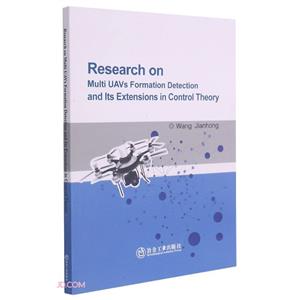-
>
湖南省志(1978-2002)?铁路志
-
>
公路车宝典(ZINN的公路车维修与保养秘籍)
-
>
晶体管电路设计(下)
-
>
无头案:雍正暴亡之谜
-
>
基于个性化设计策略的智能交通系统关键技术
-
>
花样百出:贵州少数民族图案填色
-
>
识木:全球220种木材图鉴
多无人机编队的异常检测及其在控制中的应用 版权信息
- ISBN:9787502488222
- 条形码:9787502488222 ; 978-7-5024-8822-2
- 装帧:一般胶版纸
- 册数:暂无
- 重量:暂无
- 所属分类:>
多无人机编队的异常检测及其在控制中的应用 内容简介
In Chapter 1 the idea of multi UAVs formation anomaly detection is proposed there, and its relations with system identification, advanced control theory are also introduced. After formulating the problem of multi UAVs formation anomaly detection as one system identification problem, then two spe cases are considered about its linear or nonlinear form respectively. From the detailed description on multi UAVs formation anomaly detection problem in previous Chapter 1, other interesting topics exist still, such as the nonlinear dynamic model and control strategy, so in Chapter 2 other two improved identification methods are proposed to improve the identification accuracy. Furthermore, an improved ellipsoid optimization is extended to advanced control theory. In Chapter 3, we want to study the optimal input design for multi UAVs formation anomaly detection. In order to extend the theory on optimal input design, we extend our derived theory in one control strategy-internal model control. In Chapter 4, we change to detect and identify the flutter model parameters for multi UAVs formation. After our detailed formulation, we find that this problem corresponds to one parameter identification problem too. The ground target positioning and tracking algorithm for cooperative detection of multi UAVs formation is studied in Chapter 5, where the problem of target tracking or state estimation is reduced to build ellipsoidal approximation of the considered state, whose inner and outer ellipsoidal approximations are derived through two semidefinite programs. Due to some optimization problems exist in above chapters, and as the best of our knowledge that the optimization problem is one important step in the advanced model predictive control strategy, so the mission of the Chapter 6 is to consider the same optimization problem in this model predictive control strategy. It means that system identification is combined with the model predictive control, and the interval predictor estimation is applied into robust model predictive control in case of the unmodeled noise or disturbance. Concluding remarks are provided at the end of each chapter, and In Chapter 7 we then provide a brief summary of the results presented in this monograph and an outlook to possible directions for future research on these topics.
多无人机编队的异常检测及其在控制中的应用 目录
1.1 Introduction
1.2 Bias Compensated Estimation in Multi UAVs Formation Anomaly Detection
1.2.1 Model Description
1.2.2 Anomaly Detection with Unbiased Estimation
1.2.3 Anomaly Detection with Biased Estimation
1.2.4 Simulation Example
1.3 Combining Recursive Projection and Dynamic Programming Technique in Multi UAVs Formation Anomaly Detection
1.3.1 System Description
I.3.2 Projection Algorithm with Dead Zone
1.3.3 Dynamic Programming Techniques in Anomaly Detection
1.4 Summary
Chapter 2 Synthesis Identification Analysis for Multi UAVs Formation Anomaly Detection and Its Extension
2.1 Introduction
2.2 Synthesis Analysis for Multi UAVs Formation Anomaly Detection
2.2.1 Multi UAVs Formation Anomaly Detection
2.2.2 Bias Compensated Approach for White Noise
2.2.3 An Analytic Center Approach for Bounded Noise
2.2.4 Simulation Example
2.3 An Improved Ellipsoid Optimization Algorithm in Subspace Predictive Control
2.3.1 Problem Formulation
2.3.2 Derivations of Output Predictors
2.3.3 Improved Ellipsoid Optimization Algorithm
2.3.4 Simulation Example
2.4 Summary
Chapter 3 Optimal Input Design for Multi UAVs Formation Anomaly Detection and Its Extension
3.1 Introduction
3.2 Optimal Input Deign for Multi UAVs Formation Anomaly Detection
3.2.1 Problem Description
3.2.2 Optimal Input Design for Statistical Noise
3.2.3 Conclusion
3.3 Optimal Input Design for Internal Model Control
3.3.1 Internal Model Structure
3.3.2 Equivalence between Internal Model Control and Feedback Control
3.3.3 Some Asymptotic Results in Closed Loop System
3.3.4 Optimal Closed Loop Input Signal Design
3.3.5 Simulation Example
3.4 Summary
Chapter 4 Detection and Identification for Multi UAVs Formation Flutter Model Parameters
4.1 Introduction
4.2 Combing Instrumental Variable and Variance Matching
4.2.1 Stochastic Model for Aircraft Flutter Test
4.2.2 Analysis Process
4.2.3 Instrumental Variable Variance Method
4.2.4 Asymptotic Analysis
4.2.5 Simulation Examples
4.3 Set Membership Identification
4.3.1 System Description
4.3.2 Analysis Process
4.3.3 Set Membership Identification
4.3.4 Simulation Example
4.4 Summary
Chapter 5 Target Tracking for Multi UAVs Formation Cooperative Detection
5.1 Introduction
5.2 Application of Ellipsoidal Approximation
5.2 .] Ground Target Positioning System
5.2.2 Unscented Kalman Filter Algorithm for Target Tracking Process
5.2.3 Building Ellipsoidal Approximation
5.2.4 Further Analysis on Alternative Forms
5.2.5 Simulation Example
5.3 Summary
Chapter 6 Some Extensions in Robust Model Predictive Control Based on Interval Predictor Estimation
6.1 Introduction
6.2 Basic Priori Knowledge
6.3 Some Preliminaries about State Space Equation and Interval Predictor
6.4 Interval Predictor
6.4.1 Construction of Interval Predictor
6.4.2 Explicit Form for Interval Predictor
6.5 Robust Model Predictive Control Based on Interval Predictor
6.6 Solving Min-max Optimization
6.6.1 Analysis Process
6.6.2 Gradient Projection Method
6.6.3 Simulation Examples
6.7 Summary
Chapter 7 Conclusions and Outlook
7.1 Conclusions
7.2 Outlook
References
- >
二体千字文
二体千字文
¥16.0¥40.0 - >
回忆爱玛侬
回忆爱玛侬
¥10.5¥32.8 - >
史学评论
史学评论
¥18.5¥42.0 - >
龙榆生:词曲概论/大家小书
龙榆生:词曲概论/大家小书
¥9.1¥24.0 - >
中国人在乌苏里边疆区:历史与人类学概述
中国人在乌苏里边疆区:历史与人类学概述
¥37.1¥48.0 - >
我从未如此眷恋人间
我从未如此眷恋人间
¥37.4¥49.8 - >
伊索寓言-世界文学名著典藏-全译本
伊索寓言-世界文学名著典藏-全译本
¥6.1¥19.0 - >
朝闻道
朝闻道
¥11.7¥23.8
-
塞斯纳172飞机与飞行模拟
¥47.6¥68 -
罗尔斯·罗伊斯300型航空涡轮轴发动机培训教程
¥46.5¥56 -
火箭发动机燃烧原理
¥15.4¥48 -
舰载机设计特点与技术性能分析
¥12.2¥36 -
2022图书×抽奖盲袋
¥9.9¥25 -
2023读书月阅读盲盒——天黑,闭眼,刀谁?
¥42.3¥158















